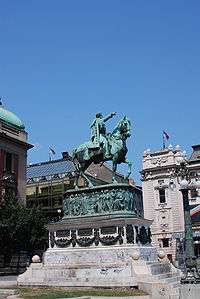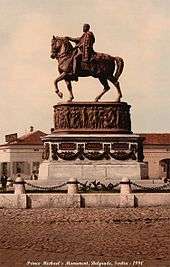Prince Mihailo Monument

Prince Mihailo Monument (Serbian: Споменик кнезу Михаилу / Spomenik knezu Mihailu) is a monument of Prince Mihailo. It is located in the main Republic Square in Belgrade, Serbia, and was erected in 1882. It was the first public monument with representation of an equestrian figure of a ruler in Serbia. The monument is by Italian sculptor Enrico Pazzi. Reliefs on the monument were performed according to the drawings of architect Konstantin Jovanović. The monument was declared a Monument of Culture of Great Importance in 1979 and it is protected by Republic of Serbia.[1]
Mihailo Obrenović III, Prince of Serbia
Prince Mihailo (1823–1868) was Prince of Serbia from 1839 to 1842 and again from 1860 to 1868. His rule began after the death of his elder brother until 1842, when he was ousted in a revolt led by Toma Vučić-Perišić.
Prince Mihailo came to the throne a second time, after the death of his father, Miloš Obrenović I, in 1860. He ruled for eight years as the absolutists, making progress in Serbia, harmonized agreements with neighboring countries, for common action in the Balkans. During the second reign of Prince Mihailo, Turkish authorities were handed over the remaining cities of Belgrade, Šabac, Smederevo, Soko, Užice and Kladovo management Serbia in 1867. In 1868, Prince Mihailo Obrenović was assassinated in the Košutnjak.
History
International Competition

During the second half of the 19th century in Belgrade, an increasing number of monuments, representing numerous prominent personalities from the cultural and political life of Serbia, were erected. The decision was made to erect a monument to Mihailo Obrenović, which would be placed at the former Theatre Square outside the National Theatre in Belgrade. In 1873 an international competition was announced; 17 works were received, mostly from foreign artists.
The winning sculptor was the distinguished Florentine master Enrico Pazzi. The Italian sculptor was born in Florence in 1819. He was a pupil of the famous sculptor Giovanni Sarti and Duperray. He was representative of the Italian verismo. His artistic direction was showing life as it is, with all its glory and despair. Pazzi had become famous for his work on a monument of the Italian writer Dante; it was erected in 1865 in front of the Florentine church of Santa Croce. Pazzi's Mihailo Obrenović sculpture was to depict the ruler on his horse—an innovation in Serbian society at that time. Work began in 1874 and was completed in 1878 when Serbia gained independence. The equestrian statue was undertaken in the classic Italian style of a ruler on a horse, having its model in ancient art. It was the first monumental equestrian statue in Serbia.[2]
Making and setting of the monument
The bronze equestrian statue of Prince Mihailo on a horse, by the Italian sculptor Enrico Pazzi was erected in 1882.[1] It was erected in honor of the Prince's most important political achievement, complete expulsion of the Turks from Serbia and liberation of the remaining seven cities within (then) Serbian territory, still under Turkish rule (1867). The names of the cities are carved on plates on the statue's pedestal, and with the Prince's hand pointing to Old Serbia, the remaining unliberated territory.[1][3]

The ceremonial unveiling of the monument took place on December 6, 1882, on the day of Saint Nicholas, patron of the dynasty Obrenovic. The event was conceived as a large ephemeral spectacle on the occasion of the proclamation of the Kingdom of Serbia. At that time, a horseman without a hat was an unusual occurrence, and was noticed by the public.[4] Revealing of Monuments was a great spectacle, On the occasion of its unveiling, stage backdrops decorated with flowers, greenery, heraldic shields with a white double-headed eagles and flags, were set. On this occasion, Enrico Pazzi, as author of one of the most important Serbian monuments of the 19th century, received the Order of the Knight of Takovo, second degree. The ceremony was attended by the highest representatives of church, state and army and large numbers of the populace. Dignitaries included the prime minister Milan Piroćanac and ministers; National assembly's deputies; Dimitrije Nešić, rector of the Great School with its professors; president and members of the Serbian Learned Society; mayor of Belgrade Mihailo Karabiberović and city council members and delegates from throughout Serbia. The monument was unveiled when King Milan and Queen Natalija arrived.[5] The whole event was attended by the press of that time and above all by the "Serbian Newspapers". The ceremony was designed to demonstrate the power of the newly proclaimed Kingdom.[2]
The monument is of bronze and is composed of three parts: the plinth, the pedestal and the equestrian statue. The bronze figure represents the prince on the horse, the Serbian liberator from the Turks, whose outstretched arm points to yet oppressed areas. The raised arm, with outstretched index finger comes from militaristic corporeal rhetoric dating back to Roman tradition; in particular used later from French neoclassical art. For Prince Mihailo this gesture meant victory in the field of diplomacy, not on the battlefield. The Prince holds the reins with the left hand—the gesture symbolizing the ability of the ruler to control and manage. Prince Mihailo was presented as the savior of the nation who sacrificed himself for the nation's ideals. The pedestal is the oval type with a relief frieze. The representations on the front and rear frieze are taken from the circle of dynastic mythology that celebrates antiquity and heroism of the Serbian people and their renewal under the Obrenović dynasty.

The scene of the "Serbian Gusle Player" is on the back north side, surrounded by people dressed in different costumes, which points to different ethnic boundaries of the nation, far beyond the political borders that existed in the period of the Principality of that time. On the front south side is the representation "The Prince Milos in Takovo" pointing to the idea of dynastic and national continuity, and to the idea of war for the liberation of homeland.[2] On the east and west side of the monument are reliefs which glorify Prince Mihailo. On the east side is the "National Deputation in front of the Grand Duke Mihailo," based on the idea of restoration of the golden period in the restored state and on the west side is the representation "The Serbs take an oath over the grave of Prince Mihailo". In the middle of the scene there is an ancient sarcophagus with an inscription in French, which says: "Michel III prince de Serbie". The entire pedestal with reliefs was set on a high rectangular plinth, so that the monument's location and appearance would dominate the space; in the assessment, an important visual and symbolic role is made in the elevation of the royal personage.

The emblem of Obrenović dynasty is on the front south side of the plinth, similar to the emblem on the Duke’s tomb in the Orthodox Cathedral. Three large bronze garlands are on the lateral sides, on which were inscribed in gilt letters the names of cities liberated in 1867: Belgrade, Kladovo, Soko, Smederevo, Šabac and Užice. On the back, north side is the text (in translation): “To Prince Mihailo Obrenovic III. Grateful Serbia.“ In the corners of the plinth are placed four relief trophies, and around the monument, there is a fence with candelabras.
Unveiling of the monument was followed by firing from a hundred and one cannon, and the ringing of bells from all the churches of Belgrade were heard during the ceremonial unveiling of the monument. In front of the monument the Prince was honored and the anthem sung. Journalistic sources say it was a sublime moment of the ceremony. Afterward, there was the laying of silver wreaths of glory.
The monument is 11 m (36 ft) high and 8.46 m (27.8 ft) long. It was cast in the Müller foundry in Munich, Germany and cost 300,000 dinars.[5]
The Monument to Prince Mihailo was established as a cultural monument of great value, Decision on Establishment, "Off . Gaz. SRS" No.14/79.
See also
References
- 1 2 3 Monuments of Culture in Serbia: Споменик кнезу Михаилу / Prince Mihailo Monument (SANU) (in Serbian) (in English)
- 1 2 3 beogradskonasledje.rs - Prince Mihailo Monument Retrieved 7 July 2013
- ↑ "DILEMA STAROG BEOGRADA: Šta pokazuje ruka kneza Mihaila na Trgu Republike?". 4 August 2015.
- ↑ Scandal at Monument bareheaded Prince Retrieved 29 July 2014
- 1 2 "Iz starog Beograda - spomenik knezu Mihailu", Politika (in Serbian), 25 June 1967
External links

Coordinates: 44°48′59″N 20°27′36″E / 44.816460°N 20.460080°E